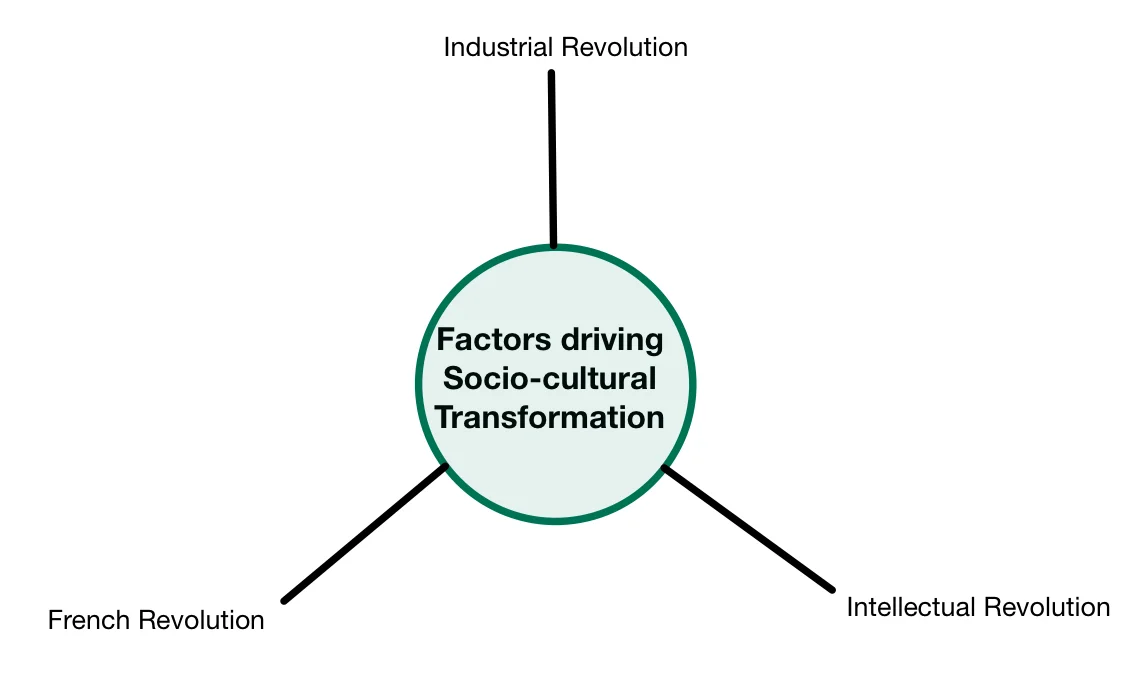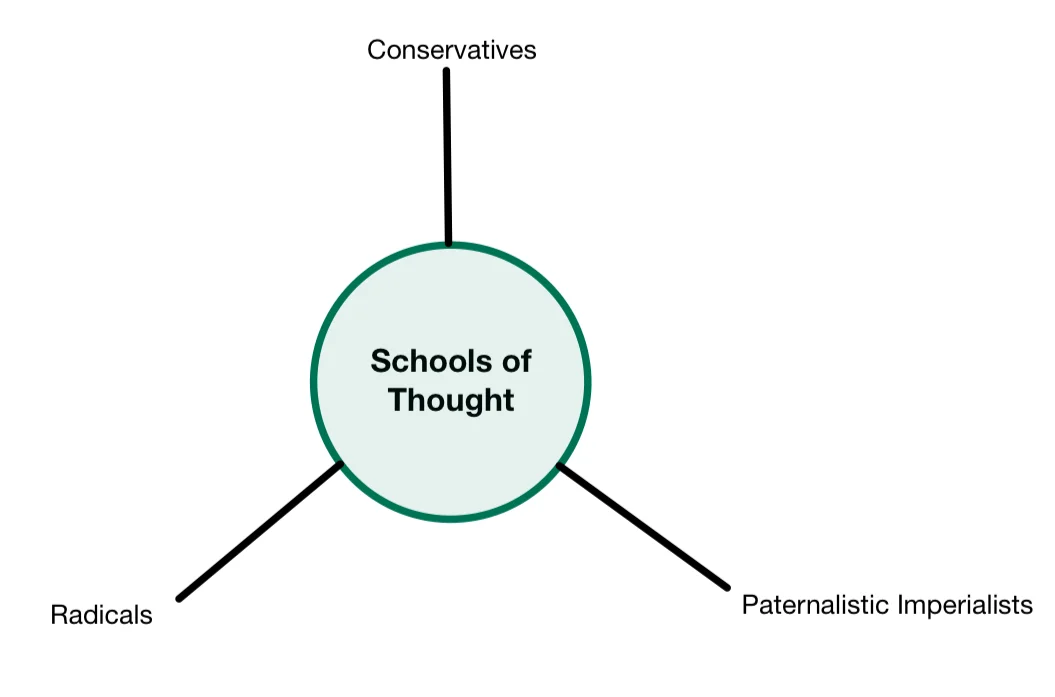Up until 1813, the British followed a policy of non-interference in India’s social, religious, and cultural life. However, after 1813, influenced by the Industrial and Intellectual Revolutions and the French Revolution, they initiated efforts to transform Indian society and culture. These changes were driven by the need to facilitate trade and the spread of new ideas, significantly altering the social and cultural landscape of India.
Social and Cultural Policies in Colonial India
Factors Influencing Social and Cultural Transformation in Colonial India Post-1813
- European Influences Prompting British Policy Changes in India: Up until 1813, the British followed a policy of non-interference in India’s social, religious, and cultural life.
- However, after 1813, steps were taken to transform Indian society and its cultural landscape due to the emergence of new interests and ideas in Britain during the 19th century.
- These changes were influenced by significant developments in Europe during the 18th and 19th centuries.
- The key factors driving the social and cultural transformation were:
- Industrial Revolution: The Industrial Revolution, which began in the 18th century, led to the growth of industrial capitalism.
- The rising industrial interests in Britain sought to expand their markets, and India became a significant target.
- This necessitated the partial modernization and transformation of Indian society to facilitate trade and commerce.
- Intellectual Revolution: This era gave rise to new attitudes of mind, manners, and morals.
- Intellectual developments played a crucial role in shaping the ideas and ideologies that would influence India’s transformation.
- French Revolution: The French Revolution, with its message of liberty, equality, and fraternity, unleashed the forces of democracy and nationalism.
- This movement was reflected in the thoughts of prominent figures such as Bacon, Locke, Voltaire, Rousseau, Kant, Adam Smith, and Bentham.
- In literature, it was represented by writers like Wordsworth, Byron, Shelley, and Charles Dickens.
- Efforts Initiated by the British Colonial Administration: These changes in Europe and the emergence of new ideas and interests prompted the British colonial administration in India to initiate efforts aimed at altering the social, religious, and cultural fabric of the country.

Enroll now for UPSC Online Course
Characteristics of New Thought
Some of the characteristics of the new wave of thought during this period included:
- Rationalism: This philosophy advocated faith in reason and a scientific attitude.
- It encouraged the use of logic and evidence to understand and address the challenges of the world.
- Humanism: Humanism emphasized the love and respect for humanity, asserting that every individual is an end in themselves and should be valued and respected as such.
- It rejected the idea of viewing one person as merely a means to another person’s happiness.
- These ideals gave rise to concepts like liberalism, socialism, and individualism.
- Doctrine of Progress: According to this doctrine, nothing is static, and all societies must evolve and adapt over time.
- It recognized that humans have the capacity to shape and transform both nature and society along just and rational lines, emphasizing the importance of continuous improvement and development.
Schools of Thought
The emergence of these new intellectual currents led to conflicts among administrators and gave rise to different schools of thought within the British colonial establishment in India
Conservatives School of Thought
- Minimal Changes Advocated: The Conservatives advocated introducing as few changes as possible.
- Respect for Indian Civilization: They believed that Indian civilization was distinct from European culture but not necessarily inferior.
- Many of these thinkers held a deep respect for Indian philosophy and culture.
- Gradual and Cautious Introduction of Western Ideas: If Western ideas and practices were to be introduced, it should be done gradually and cautiously, with a focus on maintaining social stability.
- Prominent Figures: Early representatives of this school of thought included figures like Warren Hastings and Edmund Burke, while later proponents included Munro, Metcalfe, and Elphinstone.
- The Conservatives maintained their influence throughout, and a significant majority of British officials in India adhered to this conservative perspective.

Paternalistic Imperialist School of Thought
- Criticism of Indian Society and Culture: The Paternalistic Imperialists were highly critical of Indian society, viewing it as backward and in need of reform.
- They believed that Indian culture, traditions, and social practices were inferior to European norms and needed to be changed to align with Western ideals.
- Justification for Subjugation: This critical view of Indian society was used as a justification for the economic and political subjugation of India.
- By portraying India as needing “civilizing,” the Paternalistic Imperialists argued that British colonial rule was beneficial for the Indian people, even though it primarily served the interests of the British Empire.
- Increased Influence After 1800: The Paternalistic Imperialist perspective gained significant traction in British policy towards India after 1800, influencing both the social and economic strategies of the British colonial administration.
Radicals School of Thought
- Beyond Conservative and Imperialist Criticisms: The Radicals went beyond the narrow criticisms and imperialistic views of the Conservatives and Paternalistic Imperialists.
- Belief in India’s Capacity for Improvement: They applied advanced humanistic and rational thought to the Indian situation, believing that India had the capacity for improvement.
- Advocacy for Western Science and Philosophy: They aimed to integrate India into the modern progressive world of science and humanism and advocated the introduction of modern Western science, philosophy, and literature.
- Some British officials who arrived in India after 1820 aligned with the Radicals.
- Support from Indian Reformers: They received strong support from Indian reformers like Raja Rammohan Roy, who shared their vision for change and progress.
- Imperialistic Constraints: However, despite the presence of Radicals, the dominant elements within the British Indian administration continued to be imperialistic and exploitative.
- They believed that modernization in India had to occur within certain limits to facilitate the more thorough exploitation of its resources.
- In this respect, the Radicals often aligned with a conservative approach, with the primary goal being the preservation and perpetuation of British rule in India, making all other considerations secondary.
Indian Renaissance
- Advocacy for Social Reform: Many Indians actively spearheaded social reform efforts and advocated for legislative changes to address and eliminate deeply entrenched social issues rooted in so-called tradition.
- Prominent Reformers: Figures like Raja Rammohan Roy, Ishwar Chandra Vidyasagar, and B.M. Malabari, among others, were dedicated social reformers who tirelessly worked to persuade the government to enact laws aimed at eradicating these social evils.
- Impact on Indian Society: Their persistent efforts played a crucial role in driving significant social changes, influencing the government to pass laws that aimed to eradicate these social injustices.
- The work of these reformers laid the foundation for a more progressive and equitable society in India.
Dilemma Before the Government
- Apprehension About Excessive Modernization: The colonial government was apprehensive that excessive modernization might give rise to forces antagonistic to their interests.
- Selective Introduction of Modernization: To manage this risk, the British adopted a strategy of selective modernization.
- They introduced Western ideas and practices in certain areas—such as education, infrastructure, and law—while resisting or obstructing changes that might empower the Indian population or threaten their control.
- Colonial Modernization: This approach, known as ‘colonial modernization,’ aimed to modernize India in ways that aligned with British interests, ensuring that the reforms would maintain British supremacy and control.
- While some aspects of Indian society were modernized, others were deliberately restricted to avoid undermining colonial authority.
Role of Christian Missionaries
- Promotion of Christianity and Westernization: The missionaries viewed Christianity as a superior religion and aimed to promote it in India through a process of westernization.
- Erosion of Indigenous Faith and Culture: The missionaries believed that their efforts would gradually erode the faith of the indigenous people in their own religions and cultural practices.
- They saw this as a necessary step for “civilizing” India and aligning it with Western norms.
- Missionary Goals and Strategies: In pursuit of this goal, Christian missionaries:
- Supported the Radicals: They aligned with the Radicals who adopted a scientific approach.
- The missionaries believed that this scientific perspective would challenge and weaken native cultural beliefs.
- Supported the Imperialists: Missionaries also found common ground with the Imperialists, recognizing that maintaining law and order and British supremacy were essential for their missionary efforts.
- Sought business and capitalist support: They sought the support of businesses and capitalists by promising that Christian converts would become better customers for their products.
- This was seen as a way to generate economic support for their religious mission.
- Supported the Radicals: They aligned with the Radicals who adopted a scientific approach.
Post-1858 Shift in British Modernization Policy
- Discarding Cautious Modernization: Following 1858, the policy of cautious modernization was gradually discarded.
- This shift occurred in the wake of the Indian Rebellion of 1857, which led to the dissolution of the East India Company and the establishment of direct Crown rule.
- Embrace of Modern Principles by Indians: Indians rapidly embraced modernization, transforming their society by integrating modern principles such as liberty, equality, and justice.
- This period saw a surge in efforts to assert cultural identity and demand governance based on these modern ideals.
- British Response to Indian Modernization: They asserted their cultural identity and demanded governance based on modern ideals of liberty, equality, and justice.
- British Response to Indian Modernization: However, in response to these changes, the British shifted their support towards the socially orthodox and conservative elements of Indian society.
- Promotion of Casteism and Communalism: To further their divide-and-rule strategy, the British actively promoted casteism and communalism.
- This exacerbated divisions within the Indian population, creating social fragmentation that the British could exploit to maintain their dominance.
Enroll now for UPSC Online Course
| Must Read | |
| Current Affairs | Editorial Analysis |
| Upsc Notes | Upsc Blogs |
| NCERT Notes | Free Main Answer Writing |
Conclusion
Despite initial resistance and selective modernization by the British, many Indians embraced the principles of modernization and worked towards social reforms.
- Figures like Raja Rammohan Roy played crucial roles in driving change, even as the British shifted their support towards conservative elements to maintain control.
- Ultimately, the clash of these forces led to a complex interplay between tradition and modernity in colonial India.
Sign up for the PWOnlyIAS Online Course by Physics Wallah and start your journey to IAS success today!
| Related Articles | |
| Impact of French Revolution On India | European Union (EU) |
| Fifth Industrial Revolution Or IR 5.0 | Economic Impact Of British Rule In India |

 GS Foundation
GS Foundation Optional Course
Optional Course Combo Courses
Combo Courses Degree Program
Degree Program












